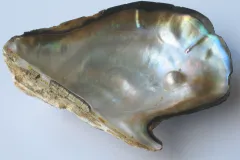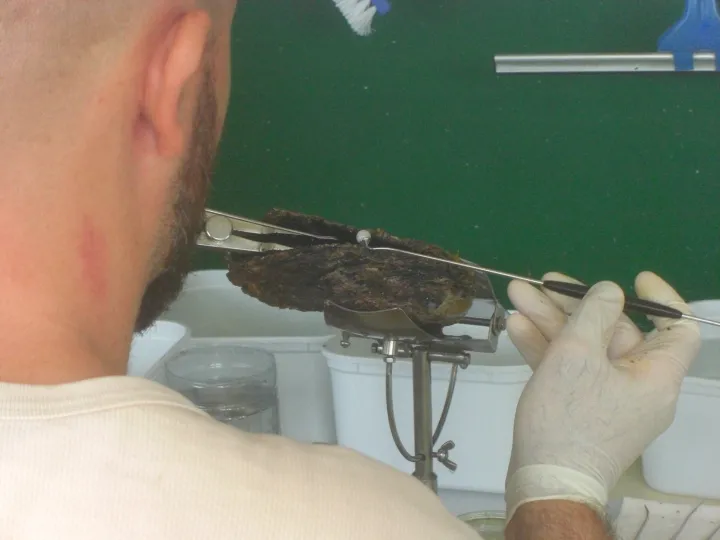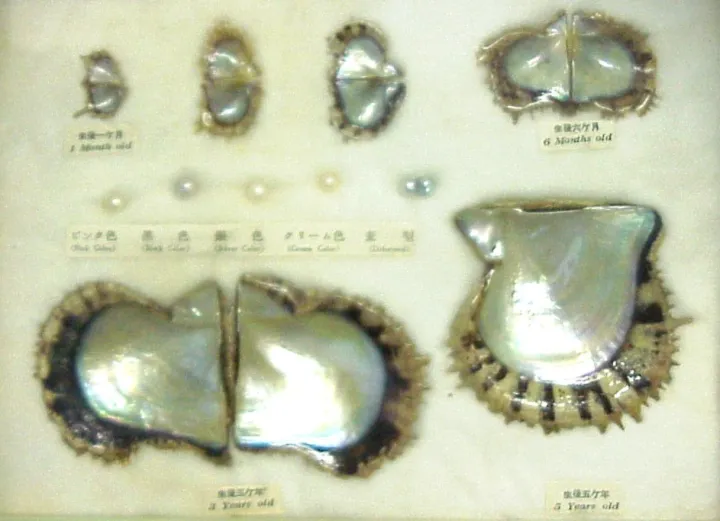How Oysters Create the Ocean’s Gems

For a pearl, the world is literally its oyster. And lucky for the world, pearls came out of their shells.
Throughout 6,000 years of human history, these gems of the sea have traveled to high places — from being worn by Roman aristocrats (per the law of Julius Caesar) to being donned by Queen Elizabeth I for a 1595 portrait. In Hindu legend, it was the god Krishna who gave his daughter something new as a wedding present, after picking the very first pearl straight out of the ocean. In fact, the English word baroque stems from Barrueca, the Spanish term used in the New World pearl trade to describe an irregularly shaped pearl.
Boasting a fascinating scientific backstory, today’s pearls must also contend with the consequences of human influence: both negative and positive.
On Forming A Pearl
Pearls frequently originate from the aptly named pearl oysters (Pinctada), a group of shelled mollusks that house a soft-bodied organism within a “two-part hinged shell”, or what scientists call a bivalve. Several species of pearl oyster exist, including the Akoya and the Golden Lip, in addition to the Black-lipped, which produces the Tahitian black pearl. “A group of animals called ‘Pearl Oysters’ produce some of the most sought after pearls,” said Dr. John Pfeiffer, research zoologist and curator of bivalves at the Smithsonian’s National Museum of Natural History. “And those animals are a very different group in comparison to the oysters that you typically find at a restaurant.”
When an irritant like a parasite or a worm breaks into the inside of a pearl oyster, the mollusk encases its intruder on all sides with a secreted coating of calcium carbonate, the same mineral found in its shell. “It’s kinda like an ectopic pregnancy, where an embryo is developing in the wrong place. That’s essentially how a pearl is made — the bivalve’s shell-producing tissue gets misplaced, and that ectopic or misplaced tissue creates a pocket, called a pearl sac, and that’s where a pearl can be made,” said Pfeiffer.
This pearl sac, glistening in a polished substance called nacre or mother-of-pearl, obtains its signature white or black color from light that scatters within the layers of flat, pancake-shaped crystals in the pearl. As it develops, the pearl alternates between thin and thick layers of nacre, thereby helping correct for structural defects in growth and creating a natural form of symmetry, on top of giving it resilience to fracturing. In the wild, there’s only a one in 10,000 chance you’ll come across a pearl, so you’re better off trying your luck with one of the cultured varieties.
As opposed to natural pearls, cultured pearls emerge from a process called nucleating, which is when human hands put mother-of-pearl beads and oyster tissue cells inside oysters to substitute for organic irritants. Countries all over the world practice the aquacultural art of marine pearl farming, such as Japan (which gave birth to the business), as well as Australia, the Philippines, and Mexico.
From filtering water and eliminating heavy metals to providing habitat for fish spawning and contributing to the Blue Economy, pearl oysters — and by extension, pearls — have much to offer as animals in service of the environment. “As a gemstone that can provide these benefits, they could ‘stand out’ alongside other gems that are typically produced through mining and extractive industries,” said Dr. Heidi Alleway, senior aquaculture scientist for The Nature Conservancy.
From an economic perspective, farmed pearls translate into major profits, with the industry valued at $200 million in 2021. In French Polynesia alone, 22,000 acres (35 square miles) across 30 islands host pearl farms. Despite such impressive statistics, modern-day pearls are growing up in a world imprinted by humans.
Climate and Conservation
Today, the changing world presents challenges to pearl oysters around the globe.
“Pearl oysters face many of the same threats affecting marine biodiversity more broadly, including rising ocean temperatures, ocean acidification, as well as the increased storm frequency and intensity, all of which are associated with climate change,” said Pfeiffer.
Based on research conducted with Atlantic pearl oysters in the presence of phenanthrene — a substance in crude oil — scientists suggest that both climate change and pollution impact pearls. In a 2023 study, researchers found that in warmer and more acidic seawater, oysters accumulated higher concentrations of phenanthrene in their tissue. At the same time, the genes responsible for calcification expressed themselves less often, which could result in “lower-quality pearls” going forward.
At pearl farms, synthetic plastic equipment poses a risk of small but mighty proportions. When exposed to micro-nanoplastics as part of a 2018 experiment, black-lipped pearl oysters in French Polynesia activated stress responses and ate more microalgae to make up for losses in energy. According to one pearl technician, warmer waters can also trigger higher food intake in oysters, leading the bivalves to create irregular pearls that are difficult to match in jewelry sets.
“Some of the biggest threats to industry, and the pearl sector, come from how these different impacts compound each other — the cumulative effects of, for example, climate change and changing sea surface temperatures or ocean acidification, as well as increased organic nutrients and eutrophication, sedimentation, and plastic pollution,” said Alleway. “One stressor may not always be significant, but together, multiple stressors can have a huge impact.”
Pearl farmers can take steps to ensure their operations remain sustainable. For instance, biofouling occurs when organisms like barnacles and sponges settle on or inside oyster shells, making themselves comfortable and rendering the oysters more susceptible to disease and stunted growth. In response, those farmers who institute a regular cleaning regimen every few weeks will keep their oysters and farming equipment spick and span.
Across the world, pearl farming allows people to steward their local marine ecosystems, improve their lives, and uphold best practices. In Indonesia, local community members breed their own oysters and maintain their farming methods as a secret recipe. In Tonga, women sell pearls to support their families and purchase essential items with the income they generate.
According to Alleway, pearl farmers can further improve the sustainability of their operations by making mindful decisions about the kind of energy that powers their vessels and facilities and where their equipment ends up after retirement. “Managing pearl aquaculture activities effectively and sustainably requires farmers to be thoughtful about the impact of their operations throughout the value chain,” she said.
Whether you’re a pearl farmer or a pearl admirer, learning the backstory of the ocean’s gems is a sure way to protect these prized oceanic possessions for all they’re worth. That way, the world can be your oyster, too.



